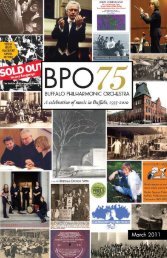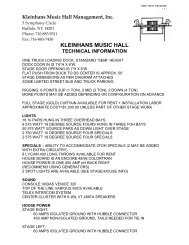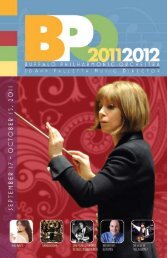Untitled - The Buffalo Philharmonic Orchestra
Untitled - The Buffalo Philharmonic Orchestra
Untitled - The Buffalo Philharmonic Orchestra
Create successful ePaper yourself
Turn your PDF publications into a flip-book with our unique Google optimized e-Paper software.
Johann Sebastian Bach<br />
German composer and organist<br />
Born: 1685, Eisenach<br />
Died: 1750, Leipzig<br />
<strong>Orchestra</strong>l Suite No.3 in D Major<br />
BWV 1068<br />
Overture<br />
Air<br />
Gavotte<br />
Bourée<br />
Gigue<br />
First Classics performance: November<br />
22, 1936, conducted by Franco Autori;<br />
most recent performance: February<br />
26, 1995, conducted by Maximiano<br />
Valdes; duration: 20 minutes<br />
<strong>The</strong> period known as the Late Baroque<br />
- with its ornateness of fashion, decor<br />
and style - is often regarded as a natural<br />
precursor to the more serious and austere<br />
Classical Age, particularly with regard<br />
to music. But another idea holds that,<br />
throughout the arts, a yin-yang momentum<br />
prevails, represented by two alternating<br />
modes: the Classical and the Romantic.<br />
From this we can infer that Bach was a<br />
Romantic; the music of Haydn, Mozart<br />
and the scores from Beethoven’s early<br />
period were Classical; what ensued<br />
was again Romanticism in Chopin,<br />
Brahms, Wagner, Tchaikovsky et al; then<br />
what followed was another period of<br />
Classicism from the early 20th Century<br />
through Schoenberg, Webern and Berg;<br />
etc. And while qualified exceptions can<br />
be made to such a rotating theory of<br />
aesthetics, the idea has held its own in<br />
the real world.<br />
Bach scored just four orchestral suites,<br />
all of which are structured similarly:<br />
an opening overture followed by a set<br />
of dance movements based on well<br />
established motifs borrowed from Italy,<br />
Spain and France.<br />
Suite No.3 in D Major was composed<br />
roughly at the time of the Brandenburg<br />
concertos, perhaps in 1720, and is<br />
scored for strings, harpsichord, oboes<br />
and trumpets, the latter assigned an<br />
ambitious role in all of the movements<br />
except the second. <strong>The</strong> Overture offers<br />
an invocation that peals as if to a<br />
firmament beyond. <strong>The</strong> slow and elegant<br />
movement which follows is sometimes<br />
known as the Air on a G String - one<br />
of the most treasured movements in all<br />
of music - a good example of why the<br />
Baroque era enjoys such a ‘Romantic’<br />
reputation. Bach then offers a rhythmic<br />
counterpoise through the remaining<br />
dance movements, each of which is a<br />
paradigm of elegance and charm.<br />
A Gavotte was originally a bright folk<br />
dance believed to have originated in<br />
the Britanny region of Northern France.<br />
Likewise, the origins of the Bourrée<br />
are also traceable to French soil,<br />
emerging first as a folk dance and then<br />
appropriated as formal entertainment by<br />
the leading courts of the 17th and 18th<br />
centuries. <strong>The</strong> provenance of the Gigue<br />
(originally ‘jig’) was altogether from the<br />
British Isles as a light, quick-stepping,<br />
common dance, here all dressed up in<br />
formal attire by Johann Sebastian. About<br />
50 years earlier a witty English writer<br />
and composer named Thomace Mace<br />
observed: Toys or Jigs are Light-Squibbish<br />
Things only fit for Fantastical and Easie-<br />
Light-Headed People. Bach would have<br />
enjoyed the word play.<br />
Program Notes by Edward Yadzinski<br />
31






